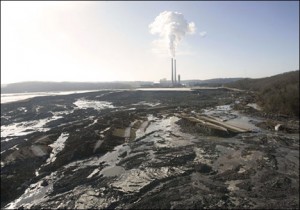Front Porch Blog

After years of hand-wringing, the first-ever rule to regulate coal ash has reached the final stage of review.
On Monday night, the U.S. Environmental Protection Agency sent a long-awaited rule to regulate the disposal and storage of coal ash to the White House Office of Management and Budget for final review.
“We are pleased to see the draft rule move into the final phase of review needed for its release in December,” says Amy Adams, Appalachian Voices’ North Carolina campaign coordinator.
“Having experienced the consequences of poor enforcement and weak or non-existent state regulations, North Carolina serves as a clear example of why states must have federal baseline standards for coal ash,” Adams says. “We must place our hope in the strength of the EPA rules and the resolve of the federal government to protect citizens from this toxic waste.”
Observers say the administration should have enough time to finalize the rule by the EPA’s court-ordered deadline of Dec. 19, which the agency apparently “fully expects” to meet.
Until then, however, we won’t know much about how far the rule will go to protect communities across the United States from coal ash pollution.
Infographic: The Truth About Coal Ash
At least for the next several weeks, the substance of the rule is still subject to change and there are a few different ways it could go. Environmental groups have for years pressured the EPA to regulate coal ash as the dangerous substance that it is. This option would classify coal ash as a hazardous waste under Subtitle C of the Resource Conservation & Recovery Act. Utilities and other industries hope the rule will regulate coal ash under Subtitle D of RCRA, which emphasizes state oversight and enforcement through citizen lawsuits.
In both scenarios, the EPA says it won’t regulate the use of coal ash in concrete and other construction material, or as fill material — the latter will fall under the Office of Surface Mining Reclamation and Enforcement’s upcoming Mine Fill Rule. Beyond that, the description of the rule on OMB’s website offers little insight, which may be just how the White House wants it.
As Earthjustice’s Lisa Evans points out, the OMB review process is “a black box — opaque, inscrutable and exceedingly dangerous. Rules never come out the way they go in — the offices of OMB are littered with crumpled pages of strong rules gone soft after revision by the White House.”
Evans uses an example from 2009, when former EPA Administrator Lisa Jackson sent the White House a plan to regulate coal ash as a hazardous waste following the largest coal ash spill in U.S. history.
Timeline: Five years after the TVA coal ash disaster, what do we have to show for it?
The EPA received more than 400,000 comments on the rule, and thousands attended public hearings to support stronger protections. But heavy lobbying by the coal and utility industries ultimately weakened the administration’s resolve.
Since then, the EPA hasn’t exactly been forthcoming about the status of the rule. In fact, had it not been for a lawsuit brought against the EPA by Earthjustice on behalf of Appalachian Voices and other environmental and public health groups last year, the timeline for a final rule might still be murky.
While unavoidable, Evans says the OMB review “introduces uncertainty at the end of a rulemaking process that must, by law, be based on science and transparency and governed by the requirements of the enabling statute.”
The evidence that coal ash poses significant risks to human health is abundant, and the need to do more could hardly be more urgent. The White House should listen to the thousands of citizens demanding strong protections against coal ash pollution.
Learn more about Appalachian Voices’ work to clean up coal ash.
PREVIOUS
NEXT
Related News

Leave a comment
Your email address will not be published. Required fields are marked *
